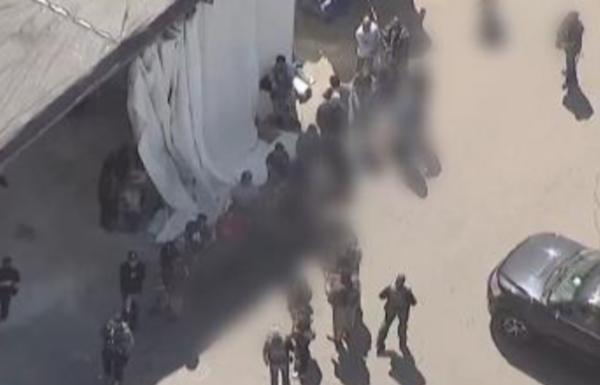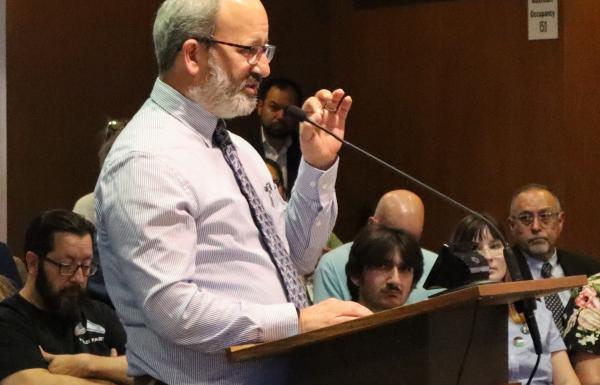Features, Food & More
Latest articles
EGG PRICES STILL RISING RAPIDLY AMID AVIAN FLU OUTBREAKS; JUSTICE DEPT. LAUNCHES PRICE GOUGING INVESTIGATION

By G. A. McNeeley
Photo courtesy of Brian McNeeley
March 19, 2025 (Washington D.C.) — The Agriculture Department predicts egg prices could rise by more than 40%, on top of already steep price rises in 2024. While egg producers blame bird flu outbreaks, the Justice Department this month announced an investigation into whether egg producers might be sharing information and engaging in price gouging, ABC News reports.
President Donald Trump’s campaign platform including a pledge to bring down inflation including egg prices, but so far, prices continue to skyrocket. Now, the administration is offering its first details on its plan to fight avian flu and ease costs.
With an emphasis on farms tightening their measures to prevent avian flu’s spread, Agriculture Secretary Brooke Rollins says the US Department of Agriculture (USDA) will invest another $1 billion on top of the $2 billion it has already invested, since the outbreak first began in 2022, AP reports.
The main reason egg prices have climbed (hitting an all-time average high of $4.95 per dozen) is that more than 166 million birds have been slaughtered to limit the virus’ spread when cases are found. Most were egg-laying chickens. Just since the start of the year, more than 30 million egg layers have been killed.
However, new research by Food and Water Watch suggests that major egg corporations might also be using the avian flu as an excuse to raise the price of eggs, the Guardian reports.
The Price of Eggs Is Rising
The USDA is predicting that the cost of eggs will go up by 41.1% this year.
Prices have more than doubled since before the outbreak began, costing customers at least $1.4 billion last year, according to agricultural economists at the University of Arkansas. Some customers are even paying more than a dollar per egg (over $12 a dozen) in some places.
Rollins acknowledged that it will take some time before customers see an effect at the checkout counter. It takes infected farms months to dispose of deceased birds, sanitize their farms and raise new birds.
“It’s going to take a while to get through, I think in the next month or two, but hopefully by summer,” Rollins told AP News.
What Is The Administration’s Plan?
The plan calls for $500 million investment to help farmers bolster biosecurity measures, $400 million in additional aid for farmers whose flocks have been impacted by avian flu, and $100 million to research and potentially develop vaccines and therapeutics for U.S. chicken flocks, and explore rolling back what the administration sees as restrictive animal welfare rules in some states, such as California’s cage-free requirement, a humane animal treatment measure that was approved overwhelmingly by voters. However, increasing crowding by keeping poultry in cramped cages could actually increase spread of the disease.
The USDA has already paid farmers roughly $1.2 billion for the birds they had to slaughter, AP reports. The additional aid will continue going to those payments, and help farmers bring in new flocks more quickly.
The administration is in talks to import about 70-100 million eggs from abroad in the coming months, Rollins said. But there were 7.57 billion table eggs produced in the U.S. last month, so those imports don’t appear likely to make a significant difference in the market.
Trump administration officials have suggested that vaccines might help reduce the number of birds that have to be slaughtered when there is an outbreak. However, no vaccines have been fully approved for widespread use in poultry, and the industry has said the current prototypes aren’t practical because they require individual shots for each bird. Plus, vaccinated birds could jeopardize exports, since some countries have restrictions.
Fired Workers Are Being Rehired
Rollins said she believes the USDA has enough staff to respond to avian flu, even after all the cuts to the federal workforce at the direction of Elon Musk’s Department of Government Efficiency (DOGE).
“Will we have the resources needed to address the plan I just laid out? We are convinced that we will… as we realign and evaluate where USDA has been spending money, where our employees are spending their time,” Rollins told AP News.
Democratic U.S. Senator Amy Klobuchar said the new plan is an important step, but the USDA needs to confirm it rehired everyone involved in the avian flu response who was mistakenly fired.
“At a time when producers are already grappling with the bird flu, the public is facing high prices, and all Americans are on edge about what broader spread of this virus could mean, the last thing the administration should have done was to eliminate these positions,” Klobuchar told AP News. “USDA must rehire these crucial personnel immediately.”
The Agriculture Department is scrambling to rehire several workers who were involved in the government’s response to the ongoing avian flu outbreak that has devastated egg and poultry farms over the past three years.
A USDA spokesperson said the department “continues to prioritize the response to highly pathogenic avian influenza (HPAI)” and several key jobs like veterinarians, animal health technicians and other emergency response personnel involved in the effort were protected from the cuts. Some employees of the USDA’s Animal and Plant Health Inspection Service (APHIS) were also eliminated.
“Although several APHIS positions supporting HPAI were notified of their terminations over the weekend, we are working to swiftly rectify the situation and rescind those letters,” the department spokesperson told AP News.
Politico and NBC News reported that the jobs that were eliminated were part of an office that helps oversee the national network of labs the USDA relies on to confirm cases of avian flu and other animal diseases. It wasn’t immediately clear how many workers the department might be trying to rehire, or if any of them worked at the main USDA lab in Ames, Iowa.
Avian Flu Is Affecting Egg Production
Egg and poultry farmers have already been working to protect their birds by making workers change and shower before entering barns, using separate sets of tools, and sanitizing any vehicles that enter farms. The challenge is that wild birds easily spread the virus.
The department has already done biosecurity reviews on about 150 farms and only one had an outbreak afterward, the USDA said, so officials believe more can be done to protect birds and they are going to make those reviews available to more farms. Any farm that has an outbreak has to undergo a biosecurity audit, and the government will help pay up to 75% of the needed biosecurity improvements.
The vast majority of avian flu outbreaks have been on factory farms where hundreds of thousands (or sometimes millions) of egg-laying hens are caged in close proximity, creating ideal conditions for the rapid spread of infectious diseases.
If one hen is infected, federal regulations call for the entire flock at the affected site to be killed – due to the risks posed by the deadly and highly contagious virus to other poultry, animals and humans, further disrupting supply and increasing costs.
So far, 70 human cases have been confirmed in the US. One person has died and another three have required hospital treatment. Almost 1,000 cattle herds have been infected, and more than 54 million birds have been affected in the past three months. The virus has also been detected in almost every US territory.
Almost 631 million eggs were produced in January 2025 (nearly 10% fewer than January 2022, as flock sizes continue to drop). The USDA tracks pullets (the chicks hatched to replace egg-laying hens) which have been below the five-year average most months since the outbreak began in February 2022.
Corporations Are Also To Blame
While avian flu has been a principal driver of rising egg prices, the highly concentrated egg market may also be contributing, according to an analysis by Food and Water Watch (FWW).
“Bird flu does not fully explain the sticker shock consumers experience in the egg aisle… corporate consolidation is a key culprit behind egg price spikes,” Amanda Starbuck told The Guardian.
“Powerful corporations that control every step of the supply chain (from breeding hens to hatching eggs to processing and distributing eggs) are making windfall profits off this crisis, raising their prices above and beyond what is necessary to cover any rising costs,” Starbuck added.
The analysis found that in some regions, prices were going up even before the new strain of the deadly H5N1 virus had affected poultry flocks and reduced egg production. Even as egg production recovered in 2023, prices did not come down.
The country’s largest egg producer, Cal-Maine, boasted a sevenfold increase in gross profits in 2023, after increasing prices above rising costs despite its flocks not being affected by avian flu during that period.
Cal-Maine, which produces one in every five eggs eaten in the US, issued shareholder dividends totaling $250 million in 2023 – 40 times more than the previous year. The company sold 7% more eggs in 2024 (compared with 2021) and tripled its profits over the same period, according to company filings.
“The working class is struggling to afford groceries while companies like Cal-Maine are raking in huge profits and rewarding their shareholders,” Democratic congressman Ro Khanna told The Guardian. “The Trump administration has the power to lower grocery bills, but instead they are imposing blanket tariffs on allies, firing federal workers who are trying to prevent the bird flu, and putting billionaires over ordinary Americans.”
The top five egg companies own almost half (46%) of all egg-laying commercial hens. Headquartered in Mississippi, Cal-Maine is the only publicly traded US egg producer, and has 75% more hens than the next largest company.
In its financial documents, Cal-Maine suggests egg prices are outside the company’s control: “We do not sell eggs directly to consumers or set the prices at which eggs are sold to consumers.” But many of its customers rely on Cal-Maine for the majority of their egg needs, according to company filings, so the price it sells its eggs factors into grocery store prices.
Lakeside egg rancher speaks with ECM
East County Magazine spoke with Frank Hilliker, co-owner of Hilliker’s Ranch Fresh Eggs in Lakeside.
Hilliker said that while his business doesn’t have the avian flu, “it’s driven prices of eggs so high that a bunch of people don’t want to buy.”
Regarding the many chickens killed nationwide due to exposure to avian flu, Hilliker said, “When you take that kind of supply off the market,” it will heavily affect the production of eggs, as well as their prices.
Hilliker said bird flu has actually increased demand, forcing rationing of sales per customer. “We’ve always sold eggs at the farm, and we’re not selling any more eggs out of the farm now than before, but we have more customers.” He added that they also “put limits on what people can buy,” which make it so they’re, “able to spread it out a little bit more that way.”
The farm has capacity for 30,000 chickens, according to Hiilliker. As for steps being taken to prevent bird flu from infecting his flocks, Hillkier explained the farms’ health and safety protocols. “We’re locked down in our chicken areas. Everything that goes through the gates where the chickens are, is disinfected,” which includes people and equipment, he said.
Sources:
https://apnews.com/article/record-egg-prices-usda-bird-flu-virus-92e9f5fbc4e0a792be484a4aee5b9c16
https://apnews.com/article/usda-firings-doge-bird-flu-trump-fdd6495cbe44c96d471ae8c6cf4dd0a8
SANTEE COUNCIL MAKES FIRE PROTECTION ITS TOP PRIORITY
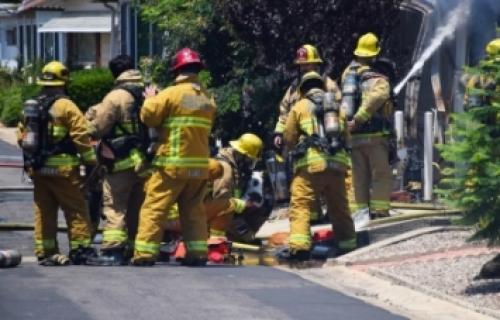
By Mike Allen
Photo by Scott Lagace: Santee firefighters saved the life of an unconscious woman during a July 2024 fire that engulfed her mobile home, also administering oxygen to save a cat.
- Read more about SANTEE COUNCIL MAKES FIRE PROTECTION ITS TOP PRIORITY
- Log in or register to post comments
SUPERVISORS WEIGH OPTIONS TO ADDRESS UNSAFE HOMELESS ENCAMPMENTS TO REDUCE FIRE DANGER
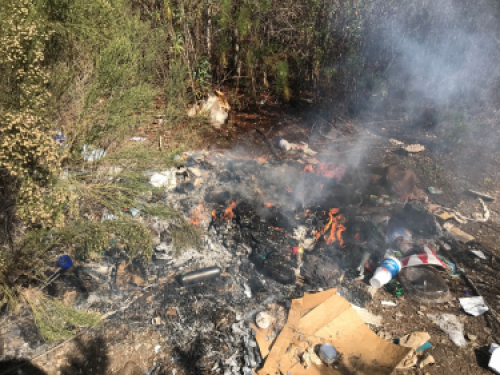
By Karen Pearlman
Photo via San Diego County Sheriff: Homeless encampment fire in Santee, February 2025
March 14, 2025 (San Diego’s East County) -- With an estimated one out of every five fires in San Diego County started in encampments where homeless individuals congregate, San Diego County Supervisor Joel Anderson has said enough is enough.
“Nobody has a right to burn my constituents’ homes down, whether they intend to or not,” Anderson said, two days after the Board of Supervisors voted unanimously to update the county’s Unsafe Camping Ordinance. It would apply to property that the county owns or leases and specified areas such as parks, open space and certain public works facilities.
At their meeting on Tuesday, March 11, the supervisors voted 4-0 to empower appropriate authorities “to ensure public safety and do more than just cite repeat offenders,” Anderson said. A final draft ordinance is expected to be presented by county staff to the board in about two months, when a final vote will take place.
At that time, Supervisors will have options for changing the current ordinance.
One option includes adding provisions related to fire risk; adding protections in specific areas (including open spaces and public works infrastructure); and a notification period of 24 hours for those living in unsheltered encampments, to give them time to move personal property.
Another option is to leave the ordinance as it is, which includes enforcement to prohibit and abate illegal encampments, remove improperly stored property on public property and protect vacant property (such as the San Diego River corridor) from fire and pollution.
Currently there are several existing state and local codes that address fire prohibitions and liabilities due to careless, negligent or intentional acts. These existing codes grant enforcement authority to local law enforcement and/or fire agencies to investigate and hold individuals accountable for unlawful acts as defined in code sections.
As for the role law enforcement and other agencies would play in enforcing the ordinance, Anderson said "We expect the draft ordinance, which will be coming back to the Board in about two months, will contain more detailed information on this piece."
 Anderson has been a leader in leading changes in the back country.
Anderson has been a leader in leading changes in the back country.
He said that passing an Unsafe Camping Ordinance in the county’s unincorporated communities “is a crucial step to protect all residents,” and referenced January’s Center Fire in Rancho Bernardo that burned seven acres.
San Diego's Metro Arson Strike Team reported that the Center Fire, which forced people in homes and those in a daycare center to evacuate, was started in a homeless encampment
Anderson said that more than 1,100 fires in the last 12 months were connected to homeless encampments.
In a staff report related to the ordinance, it was noted that the County has, and would continue to have, a “services-first” approach, with a goal of connecting people with shelter, food and -- where appropriate -- substance use disorder and mental health treatment.
The County’s outreach team -- The Health and Human Services Agency, Parks and Recreation, Public Works and Sheriff’s Office Homeless Assistance Resource Team -- coordinates provision of services and resources including emergency housing to people experiencing homelessness in the unincorporated communities.
The 2024 Point in Time Count identified nearly 200 people experiencing homelessness in the unincorporated county area. (This number captures unsheltered individuals only and does not include 250 households already placed in the County’s emergency housing program.)
The county’s changes to the ordinance are also connected to the June 2024 Supreme Court decision in the case of City of Grants Pass v. Johnson. T which allows local governments to enforce camping bans through citations or arrest regardless of the number of shelter beds open.
The decision overturned Martin v. Boise, a Ninth Circuit case from 2018 that held that individuals could not be cited for sleeping on public property unless they were first offered alternative shelter.
In Grants Pass, the Supreme Court upheld enforcement of local ordinances regulating camping on public property even if no shelter beds were available. Under this new guidance, the county’s existing camping ordinances could be enforced.
While all Supervisors voted for drafting an update to the county’s Unsafe Camping Ordinance, Supervisor Monica Montgomery-Steppe wants to be sure shelter space is available for anyone displaced. The County currently operates no homeless shelters, other than two safe parking areas for unhoused people living in vehicles, though plans are in the works to build sleeping cabins in Lemon Grove.
"We have a moral obligation before we put handcuffs on somebody to say, `We have a place for you to go," Montgomery-Steppe said, ECM news partner 10 News reports.
Asked if there is information on any separation of homeless encampment fires vs. fires started in migrant camps, Anderson said County Fire and CalFire have indicated that “these separate data points are not currently tracked in the unincorporated areas.”
An ECM article last year reported that at least six local fires between May 1 and June 1 were attributed to migrants or smugglers near the border, according to Cal Fire. Those fires ranged in size from less than an acre to 50 acres.
STORM SERIES MOVING INTO AREA: FLOOD WATCH ISSUED

East County News Service
Last week’s storms brought 6-10 inches of snow to our mountains with up to 1.5 inches in urban portions of our county. Now, multiple new storms are moving into the area, with rain now falling across the region and multiple atmospheric rivers soon to drench our region, with the heaviest rains Thursday, the National Weather Service predicts. A flood watch has been issued now through Thursday afternoon for San Diego’s inland and coastal areas, including cities such as La Mesa, Santee, Poway, and Escondido as well as San Diego. Excessive runoff may result in flooding of rivers, streams, and other low-lying and flood-prone locations.
Wednesday night through Thursday afternoon could bring rainfall rates of .5 to 0.75 inches per hour, with up to an inch per hour possible in lower mountain areas, along with thunderstorms. Two to three inches of snow are forecast at higher elevations locally. A winter storm warning will remain in effect from Wednesday afternoon through Friday morning.
Travel could be very difficult to impossible. The hazardous conditions could impact the Tuesday morning and evening commutes. Very strong winds could cause extensive tree damage. Roads, and especially bridges and overpasses, will likely become slick and hazardous. Visibilities may drop below 1/4 mile due to falling and blowing snow.
Yet another storm is possible Sunday and Monday, with continued colder than normal temperatures.
Sign up to receive free East County Wildfire and Emergency Alerts via email on the top right of our homepage. You can also follow EastCountyAlert at X.
- Read more about STORM SERIES MOVING INTO AREA: FLOOD WATCH ISSUED
- Log in or register to post comments
ARREST MADE FOR SUSPECTED ARSON IN PALA AND LILAC FIRES
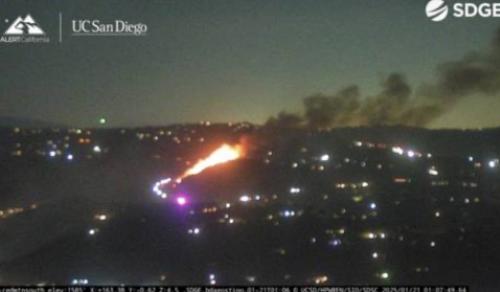
Source: Cal Fire
March 2, 2025 (San Diego) – Cal Fire law enforcement investigators have arrested Ruben Vasquez on multiple felony arson charges following an extensive investigation into two wildland fires that ignited on January 21. The fires, known as the Pala Fire and the Lilac Fire, started 25 minutes apart near Interstate 15 and State Route 76 in the Pala Mesa and Bonsall areas.
Together, they burned nearly 100 acres and prompted evacuations affecting hundreds of residents. Witness reports and investigative efforts led to the identification of Vasquez as a suspect.
On February 28, Cal Fire Law Enforcement Investigators arrested Vasquez for two counts of felony arson, and he was transported to the Vista Detention Facility. The investigation report will be referred to the San Diego County District Attorney’s Office.
Cal Fire indicates that arson investigations are complex and require thorough evidence collection, scene examination, and witness interviews, which can be time-consuming. Accurate findings are essential for accountability and preventive measures.
Cal Fire extends gratitude to its partners at the San Diego County Sheriff's Office, North County Fire Protection District, U.S. Customs and Border Protection and the San Diego County District Attorney’s Office for their valuable support and assistance during the investigation.
Wildfires
FLOOD WATCH ISSUED FOR THURSDAY AND FRIDAY
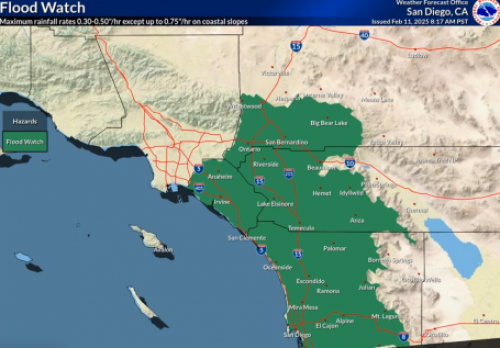
East County News Service
February 12, 2025 (San Diego's East County) -- An atmospheric river is moving into our region, bringing rain today with heavier rain late Thursday and Friday. A flood watch has been issued starting Thursday afternoon through Friday.
The Pacific storm could bring up to 7 inches on Mt. Palomar, up to 5 inchesin Julian, 2-3 inches in valleys, and up to an inch in some desert areas, with snow at higher elevations, up to two inches above 6,000 feet. Strong wind gusts in mountains up to 70 miles per hour and up to 50 mph in deserts are forecast.
California Highway Patrol is warning of winter storm conditions this morning on I-8 east of Willow Road in Alpine.
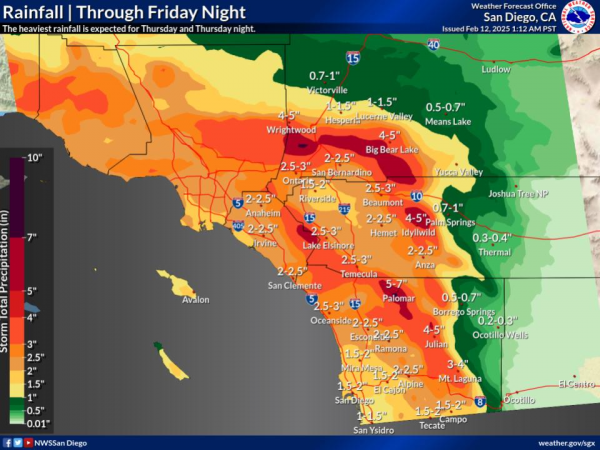 The County urges residents to be prepared. Check your home by clearing rain gutters, checking storm drains and if needed, pick up sandbags. Go to http://AlertSanDiego.org to sign up for county emergency alerts and more tips.
The County urges residents to be prepared. Check your home by clearing rain gutters, checking storm drains and if needed, pick up sandbags. Go to http://AlertSanDiego.org to sign up for county emergency alerts and more tips.
Mudslides are possible in recently burned areas.
The rainfall is needed, since southern California is now in severe drought conditions, according to the National Weather Service.
Dry, warmer weather is expected over the weekend.
- Read more about FLOOD WATCH ISSUED FOR THURSDAY AND FRIDAY
- Log in or register to post comments
HOW TO STAY SAFE IN RAINY CONDITIONS
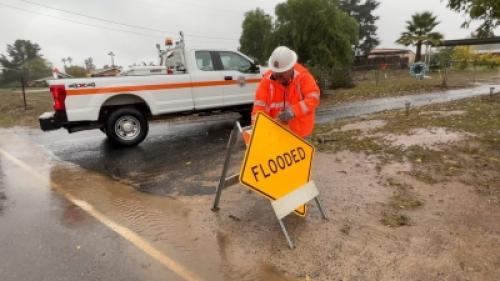
By Yvette Urrea Moe, County of San Diego Communications Office
February 11, 2025 (San Diego) - With rainy weather in the forecast, including the chance of flooding in some low-lying areas, emergency officials offer seven safety tips.
If you must drive during heavy squalls, allow yourself extra time, turn on headlights even in the day, and give plenty of space between your vehicle and the one in front of you.
- When approaching a flooded roadway with moving water, do not attempt to drive through it. It only takes a few inches of water to get a vehicle to float away, and there’s no guarantee the roadway below hasn’t been washed out. You can report flooded roadways or other unsafe road issues in the unincorporated area by calling (877) 684-8000.
- The same caution is true for pedestrians, if moving water can sweep a car away, it can easily do the same to people. Do not try to wade through a flooded roadway.
- If your home gets an evacuation warning, or if you feel unsafe, evacuate.
- Stay informed on adverse weather conditions, with official information from the National Weather Service or news outlets.
- Visit AlertSanDiego.org for disaster preparedness tips including flooding.
- To receive emergency alerts for your area, download the Genasys Protect app or in the App Store or Google Play.
- Read more about HOW TO STAY SAFE IN RAINY CONDITIONS
- Log in or register to post comments
SENATOR PADILLA INTRODUCES BIPARTISAN BILLS TO IMPROVE FIRE MITIGATION AND RESILIENCY
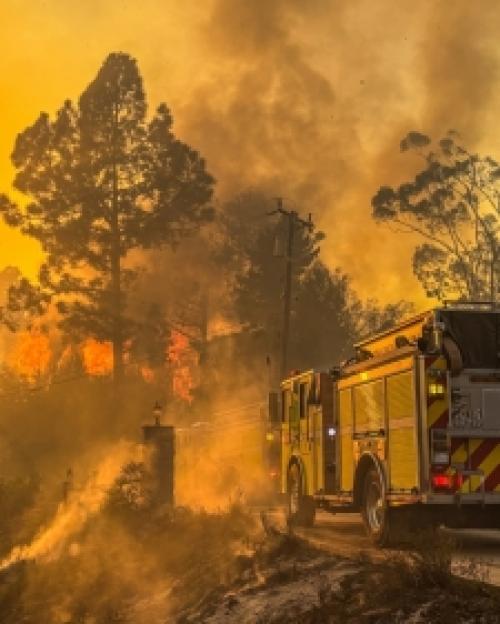
East County News Service
Photo: Palisades Fire, courtesy of Lakeside Fire Dept. which helped battle the catastrophic wildfire in Los Angeles County in January
February 11, 2025 (Washington D.C.) -- As Southern California recovers from devastating wildfires, U.S. Senator Alex Padilla, a California Democrat, has introduced a package of three bipartisan bills to bolster fire resilience and proactive mitigation efforts.
The package includes the Wildfire Emergency Act, to support forest restoration, wildfire mitigation, and energy resilience; the Fire-Safe Electrical Corridors Act, to authorize the removal of trees or other vegetation within existing electrical utility corridors; and the Disaster Mitigation and Tax Parity Act, to further incentivize homeowners to proactively protect their homes from disasters.
The package of bipartisan bills comes as Southern California begins the recovery from one of the worst natural disasters in state history. The Palisades and Eaton fires in Los Angeles County burned over 57,000 acres and destroyed over 16,200 structures, claiming the lives of at least 29 victims, according to Cal-Fire.
“The devastating fires in Southern California are a harsh reminder of the importance of proactive fire mitigation efforts to keep families and homes safe,” said Senator Padilla. “As these disasters become more frequent and more extreme, we need to find smarter solutions to strengthen fire resilience across the country. From expediting the removal of hazardous fuels near power lines, to supporting our wildland firefighting forces, to hardening homes and energy facilities, these commonsense bills would help reduce the threats of catastrophic fires to California communities.”
“Montanans see firsthand the effects that catastrophic wildfires have on our communities. These bipartisan bills will streamline forest management processes to mitigate the root causes of wildfires, improve community and home hardening efforts, and support our brave firefighters. I’ll work every day for more solutions to keep our state safe,” said Senator Steve Daines (R-Mont.), co-lead of the Wildfire Emergency Act and the Fire-Safe Electrical Corridors Act.
“This commonsense legislation takes a critical step toward empowering individuals and communities to better protect themselves from the devastating effects of natural disasters like Hurricane Helene,” said Senator Thom Tillis (R-N.C.), co-lead of the Disaster Mitigation and Tax Parity Act. “By excluding qualified catastrophe mitigation payments from income tax, we are incentivizing property owners to make the necessary improvements that reduce damage and save lives. This proactive approach to disaster preparedness not only helps families rebuild faster but strengthens our resilience in the face of future disasters.”
“We have seen how natural disasters have devastated communities around the country, and we must ensure we have the resources and programs in place to respond. Homeowners should not face additional taxes for wanting to protect their homes and our bipartisan legislation will provide the needed tax relief to help affected Americans recover from these disasters,” said Senator Adam Schiff (D-Calif.), co-lead of the Disaster Mitigation and Tax Parity Act.
“Louisianans understand the impact of devastating storms, but with the help of state and local programs, we have tools to rebuild and return to wholeness,” said Dr. Bill Cassidy (R-La.), co-lead of the Disaster Mitigation and Tax Parity Act. “If communities need tax relief, let’s give it to them!”
Wildfire Emergency Act
This sweeping legislation, co-led by Senator Daines, would reduce the threat of destructive wildfires through forest restoration, firefighter training, energy resilience retrofits, and wildfire-hardening home modifications in low-income communities. This bipartisan bill would take numerous steps to ensure that the Department of Agriculture (USDA), the Department of Energy (DOE), and the Department of the Interior (DOI) are better able to mitigate the risk and impact of wildfires.
Specifically, the legislation would:
- Provide the U.S. Forest Service (USFS) with a pilot authority to leverage private financing to increase the pace and scale of forest restoration projects. The USFS would be able to expand up to 20 existing collaborative forest restoration projects using this pilot authority.
- Authorize funding for programs to expand the forest conservation and wildland firefighting workforce.
- Establish an energy resilience program at DOE to ensure that critical facilities remain active during wildfire disruptions, authorizing up to $100 million for necessary retrofits.
- Expand an existing DOE weatherization grant program to provide up to $13,000 to low-income households to make wildfire-hardening retrofits, such as ember-resistant roofs or gutters.
- Expedite the placement of wildfire detection equipment on the ground, such as sensors or cameras, as well as the use of space-based observation.
- Establish a prescribed fire-training center in the West and authorize grants to support training the next generation of foresters and firefighters.
- Authorize up to $50 million to support community grants of up to $50,000 for locally focused land stewardship and conservation.
A one-pager on the bill is available here.
Full text of the bill is available here.
Fire-Safe Electrical Corridors Act
This bill, co-led by Senator Daines, would allow the U.S. Forest Service to approve the removal of hazardous trees and other vegetation near power lines on federal forest lands without requiring a timber sale, reducing the risk of catastrophic wildfires through easier material removal. The legislation advanced last year through the Senate Committee on Energy and Natural Resources as part of the Promoting Effective Forest Management Act of 2023.
Three of the largest and most destructive wildfires in California history — the 2017 Thomas Fire, the 2018 Camp Fire and the 2021 Dixie Fire — were started by electrical equipment. Together, these wildfires burned more than 1.2 million acres, destroyed more than 15,000 homes, and killed 87 people.
Currently, the USFS allows utility companies to cut down trees and branches in existing utility corridors, but some forest managers interpret the law to forbid removal of the material off the land. This creates uncertainty and can lead to an unnecessary buildup of dead, dry fuels directly under utility lines. This bill would help reduce the risk of wildfires on forest lands by ensuring the clearing of existing corridors and give certainty to utilities.
The legislation would also require any utility that sells marketable forest products from hazardous trees removed near power lines to return any proceeds to the USFS.
A one-pager on the bill is available here.
Full text of the bill is available here.
Disaster Mitigation and Tax Parity Act
This bipartisan legislation, co-led by Senators Tillis, Cassidy, and Schiff would provide a tax exemption on payments from state-based programs for homeowners to proactively harden their homes against natural disasters.
Specifically, the bill excludes from gross income calculations any qualified catastrophe mitigation payment made under a state-based catastrophe loss mitigation program. Qualifying payments are defined as any amount received and used for improvements to an individual’s property for the sole purpose of reducing the damage that would be done by a windstorm, earthquake, flood, or wildfire.
California, North Carolina, and Louisiana are among the states that provide funding to homeowners who take steps to protect their homes from natural disasters. These improvements can include removing trees, bushes, and other fire-prone vegetation close to homes that contribute to wildfires, strengthening foundations to protect against earthquakes, and installing fortified roofs to withstand hurricanes.
However, homeowners are currently required to pay federal taxes on these payments, unnecessarily limiting money available for critical disaster-related upgrades. This fix will bring parity to the tax treatment of disaster mitigation efforts and ensure taxpayers are able to put the full amount of these payments toward securing their homes.
Senators Michael Bennet (D-Colo.), Ted Budd (R-N.C.), John Hickenlooper (D-Colo.), John Kennedy (R-La.), Amy Klobuchar (D-Minn.), Jeff Merkley (D-Ore.), and Roger Wicker (R-Miss.) are cosponsoring the legislation.
Full text of the bill is available here.
Last month, Padilla introduced another package of three bipartisan bills to strengthen wildfire resilience and rebuilding efforts through legislation including the Wildland Firefighter Paycheck Protection Act, the Fire Suppression and Response Funding Assurance Act, and the Disaster Housing Reform for American Families Act. His legislation to strengthen FEMA’s wildfire preparedness and response efforts, the FIRE Act, became law in 2022.
ISSA BILL WOULD CUT ENVIRONMENTAL REGULATIONS TO ALLOW FOREST, BRUSH CLEARING ON FEDERAL LANDS

East County News Service
Photo, right: Cleveland National Forest in San Diego County
February 11, 2025 (San Diego) – Congressman Darrell Issa, a San Diego Republican, has introduced the “Green Tape Elimination Act” that seeks to prevent wildfires by exempting all fuel reduction activities on federal lands from these environmental regulations for 10 years.
- The National Environmental Policy Act
- The Endangered Species Act
- The National Historic Preservation Act
- The Clean Air Act
- The Migratory Bird Treaty Act
- The Migratory Bird Conservation Act
"For years, environmental rules have become regulatory ‘green tape’ — locking in dangerous conditions and contradicting common sense reforms," said Rep. Issa. “That’s why this is no time for tinkering around the edges. We can’t wait for the next deadly disaster."
The environmental regulations that would be waived are intended to protect wildlife habitat, natural resources, clean air, historic sites, and recreational uses on public lands such as national parks, national forests, and federal wildlife refuges.
Issa's bill would provide a decade for firefighters to clear brush, cut shrubs, prescribe control burns, and utilize other strategies to stop the fires we know will occur in the future.
San Diego County is home to multiple federal lands including Cleveland National Forest, Bureau of Land Management properties, and federal wlidlife refuges. California has many forested federal lands, including Yosemite National Park.
LEMON GROVE NONPROFITS UNITE FOR LOS ANGELES FIRE RELIEF FUNDRAISER

East County News Service
February 10, 2025 (Lemon Grove) - On Saturday, February 1, the spirit of community and compassion was on full display as Lemon Grove nonprofit organizations joined forces at Treganza Park for a heartfelt fundraiser supporting fire relief efforts in Los Angeles. Over $2,100 was raised, according to a press release from organizers.

With little time to plan, a remarkable coalition of local groups stepped up to make the event a success. Among those who contributed their time and efforts were the Lemon Grove Lions Club, Lemon Grove Forward (Women’s) Club, Lemon Grove Improvement Council, Revitalize Broadway, Lemon Grove Happenings, Lemon Grove Soroptimist, Lemon Grove Historical Society, Lemon Grove Fire Department, Lemon Grove volunteers, and GC Lemon Grove. Adding to the day’s uplifting atmosphere was the talented DJmigz, who generously donated his time to provide music and keep spirits high.
“This collaborative effort showcased the power of community action, proving that when neighbors come together, they can make a meaningful difference—even on short notice. Lemon Grove’s nonprofit organizations unwavering generosity and unity continue to shine as a beacon of hope for all of us,“ the release concludes.










